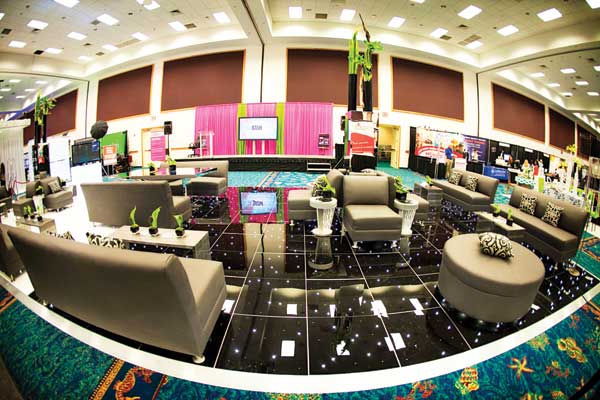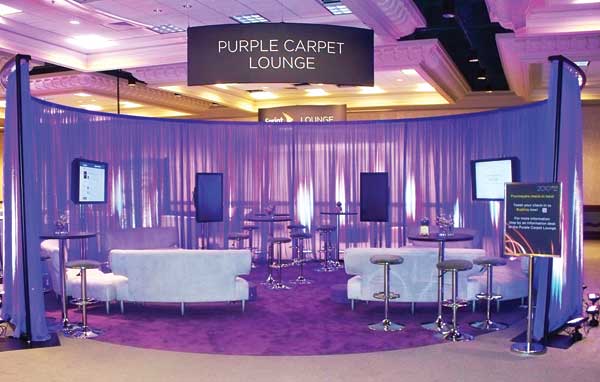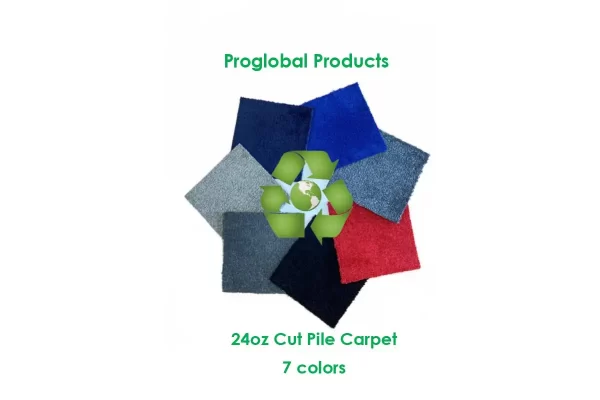When life on the show floor gets broken down to the most basic elements, success is really about getting attendees into the booth space, making them comfortable and trying to put together a deal.
While no attendee ever signed a contract just because they were sitting on a comfortable chair, the furniture that exhibit managers choose for their clients can make a difference.
“Comfortable seating placed in the right place invites attendees to come into the booth and linger long enough for booth personnel to engage potential clients in selling conversations,” said Dave Flory, director of national accounts for CORT Tradeshow and Events. “Exhibitors can also increase traffic flow by placing furniture in the center or back of the booth to draw clients inside.”
Getting attendees into the booth relies on that first impression, and furniture plays a role there.
“No matter what the theme, furniture ties all of your other elements together and makes a statement about your brand – just one of the pack, or a cutting edge leader,” said Pat Schau, AFR tradeshow manager.
With the importance the right furnishings bring to an exhibit, suppliers in the industry are taking note of several trends.
“The old matrix of dark furniture staged in a cube design has given way to more free flowing, more comfortable pieces with a broad palette of colors and textures,” said Debbi Somers, founder of Somers Furniture. “Furniture serves more than just being functional; it will either enhance or detract from the total image that the exhibitor wishes to present.”
The personalization furniture can give a booth is not necessarily a new concept, but suppliers are recognizing that it is becoming more mainstream.
“More and more we are seeing exhibitors who want to stand out and set themselves apart from the crowd,” said Schau. “One way to achieve this is by ordering furniture other than the items offered to every other exhibitor in the kit. A splash of color can add warmth and invite people into your booth. It’s white, pistachio green, regal purple, bright tangerine, and cocoa with charcoal and black thrown into the mix for a little punch. It’s citrus undertones meeting warm espresso for a fresh take on the tradeshow floor.”
Versatility is another feature that is often asked for on the show floor.
“Modular furnishings is the most important furnishings trend right now in the tradeshow industry,” said Kevin Dana, director of marketing for CORT Tradeshow and Events. “Exhibit builders and designers want the ability to customize spaces that are unique to their clients. Modular furnishings allow them to be more creative and deliver selling spaces that meet corporate selling objectives.”
To accommodate these trends, furniture companies are constantly developing new products for the show floor.
“One trend we have seen lately is exhibitors using LED-lit furniture to complement their company colors and the use of sporadic pieces of lit product to help augment their company’s image,” said Schau. “Our new Orbit series is the perfect example. It has the clean contemporary lines that go well with everything on top of a LED lighted base that can be lit in a myriad of amazing colors.”
CORT has also developed its Endless Collection, where flexibility is the key.
“Ottomans become chairs; those chairs become sofas, which in turn become high banquettes,” said Dana. “Exhibit designers can mix and match with black or white vinyl, high or low backs, and curves or straight seats. Endless Seating also allows designers to create intimate seating vignettes or extend out to make large serpentine or circular configurations.”
With such a large amount of options to think about, exhibit managers should consider the selling objectives for an exhibit and then design the space with furnishings that help achieve those goals.
“Floor plans suited for our top-end options are often open spaces that create conversation areas, where the furniture helps focus a customer on the brand message or a particular product,” said Dana. “Furniture brings structure to spaces and the proper arrangement focuses the buyer’s attention onto a particular demonstration, product, or service facilitating productive selling conversations.”

This has everything to do with space planning.
“The exhibit must have eye appeal to attract foot traffic, be free flowing and coordinated to client’s products or schematics,” said Somers. “Exhibit managers must have options to provide multiple schematics to their customer.”
According to Schau, nothing looks worse than an exhibit that gives the impression that little to no effort was put into the booth’s décor.
“Properly executed, an exhibit should flow well and convey the message the exhibitor is trying to get across to their customers – the attendees,” said Schau. “By incorporating furniture into the booth at the design stage, the furniture will not only fit into the booths décor, but can serve as a medium to express the exhibitor’s message.”
“That is one of the great things about renting furniture, whether you opt for the clean lines and timeless style of white leather or something more vibrant and contemporary, (furniture) can take your blank canvas and give it the ‘wow’ factor,” continued Schau.
Most companies have resources available to help managers achieve this “wow” factor.
“Exhibitors should make use of visual design personnel, usually a free service provided by a furniture manufacturer,” said Somers. “This will enable them to make the selection an integral part of his exhibit with optimization of choices with respect to number of pieces, types and color.”
Once the space is planned and the furniture is selected, there are still some things that exhibit managers should keep aware of.
“Exhibitors should know where their dollars are being spent,” said Steve Goldman, national service manager for CORT. “Drayage, labor, insurance, venue cost, and delivery fees (fuel), are generally included when a client orders through the exhibitor kit. While the price may seem higher than what can be bought or rented locally, in the long run, clients will spend more and have no guarantees, whereas the exhibitor kit offers a complete package at an affordable price.”
Schau echoed those remarks.
“Go with the professionals – you don’t really save money if your furniture doesn’t make it to your booth on time, or arrives in sub-par condition,” said Schau.
Budgeting is another area that varies depending on whether the furniture is being purchased or rented.
“Make certain that you consider all the costs when creating your budget,” said Kevin Nute, senior national exhibit house account executive. “If purchasing furniture, in addition to raw cost of goods, include the cost of moving, storage, drayage for the show floor, removal, cleaning and repairs. If renting, compare total cost from your provider as drayage is a significant variable component not included in the price quoted by many suppliers. Vendor partners that include drayage will ensure that you stay within your budget.”





























